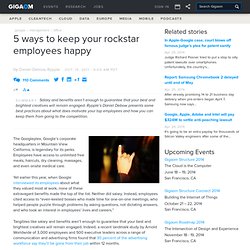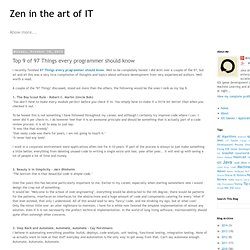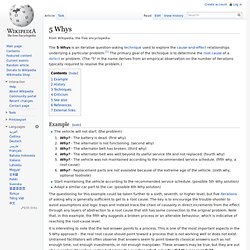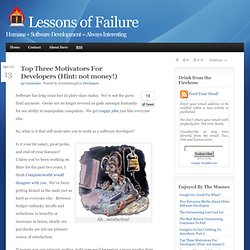

Daniel Taylor
Guide: How to fix Cydia problems / errors. LinkedIn Marketing. Management 3.0 - Leading Agile Developers, Developing Agile Lead. Management 3.0 - Management 3.0. 5 ways to keep your rockstar employees happy — Online Collaboration. The Googleplex, Google’s corporate headquarters in Mountain View California, is legendary for its perks.

Employees have access to unlimited free meals, haircuts, dry cleaning, massages, and even onsite medical care. Yet earlier this year, when Google interviewed its employees about what they valued most at work, none of these extravagant benefits made the top of the list. Neither did salary. Instead, employees cited access to “even-keeled bosses who made time for one-on-one meetings, who helped people puzzle through problems by asking questions, not dictating answers, and who took an interest in employees’ lives and careers.” Tangibles like salary and benefits aren’t enough to guarantee that your best and brightest creatives will remain engaged. Take Jill, an outstanding, experienced copy editor whom Agency X recently recruited at considerable expense from one of its chief rivals. So how can your company keep its stars engaged?
1. 2. 3. 4. Why Software Projects Fail « Fear No Project – A Project Managem. While there is great debate over why software projects fail, it is commonly believed that many— if not most—software projects fail in some way.

Because of the fear of probable failure, many organizations continue to run their organization with antiquated or outdated software and processes rather than attempt a new software implementation. As it turns out, Gartner, Inc. a leading information technology research and advisory company assessed the frequency of software project failure rates last year.
Although not quite as high as 50%, the failure rate is significant. According to the 2008 Gartner survey, projects considered failures occurred at rates of: 14% for small projects 20% for medium projects 22% for large projects Averaging about 20% for all types of projects(1) . Additionally, 25% of projects failed due to functionality issues, 15% of projects failed because of high cost variance, 20% were canceled during delivery, and 18% were unsuccessful because they were substantially late(2). Top 9 of 97 Things every programmer should know. I recently finished 97 Things every programmer should know.

Well to be completely honest I did skim over a couple of the 97, but all and all this was a very nice compilation of thoughts and topics about software development from very experienced authors. Well worth a read. A couple of the "97 Things" discussed, stood out more than the others, the following would be the ones I rank as my top 9. 1. The Boy Scout Rule - Robert C. 5 Whys. The 5 Whys is an iterative question-asking technique used to explore the cause-and-effect relationships underlying a particular problem.[1] The primary goal of the technique is to determine the root cause of a defect or problem.

(The "5" in the name derives from an empirical observation on the number of iterations typically required to resolve the problem.) Example[edit] The vehicle will not start. (the problem)Why? - The battery is dead. The questioning for this example could be taken further to a sixth, seventh, or higher level, but five iterations of asking why is generally sufficient to get to a root cause. It is interesting to note that the last answer points to a process. Why a Great Individual Is Better Than a Good Team - Jeff Stibel. Getting Real. Here are the 16 chapters and 91 essays that make up the book.

Introduction chapter 1 What is Getting Real? A smaller, faster, better way to build software About 37signalsOur small team creates simple, focused software Caveats, disclaimers, and other preemptive strikesResponses to some complaints we hear The Starting Line chapter 2 Build LessUnderdo your competition What's Your Problem? Stay Lean chapter 3 Less MassThe leaner you are, the easier it is to change Lower Your Cost of ChangeStay flexible by reducing obstacles to change The Three MusketeersUse a team of three for version 1.0 Embrace ConstraintsLet limitations guide you to creative solutions Be YourselfDifferentiate yourself from bigger companies by being personal and friendly Priorities chapter 4 What's the big idea? Feature Selection chapter 5 Process chapter 6 The Organization chapter 7 Staffing chapter 8 Interface Design chapter 9 Code chapter 10 Words chapter 11 Pricing and Signup chapter 12 Promotion chapter 13 Support chapter 14. My favorite project management links and websites « Fear No Proj.
Top Three Motivators For Developers (Hint: not money!) Software has long since lost its glory-days status.

We’re not the go-to field anymore. Geeks are no longer revered as gods amongst humanity for our ability to manipulate computers. We get crappy jobs just like everyone else. So, what is it that still motivates you to work as a software developer? Ah...satisfaction! Is it your fat salary, great perks, and end-of-year bonuses? If money was our primary motive, right now we’d be seeing a mass exodus from the tech sector. Turns out, we’re kidding ourselves if we think that’s our real motive as developers.